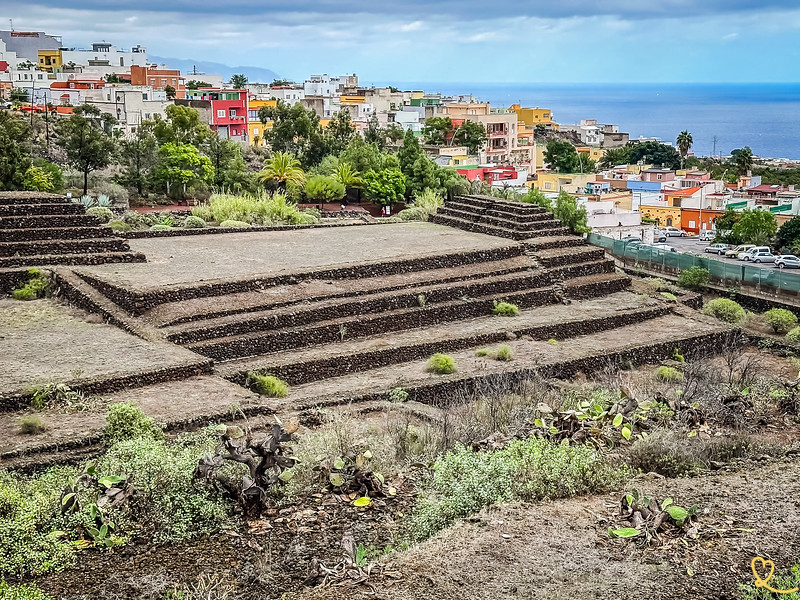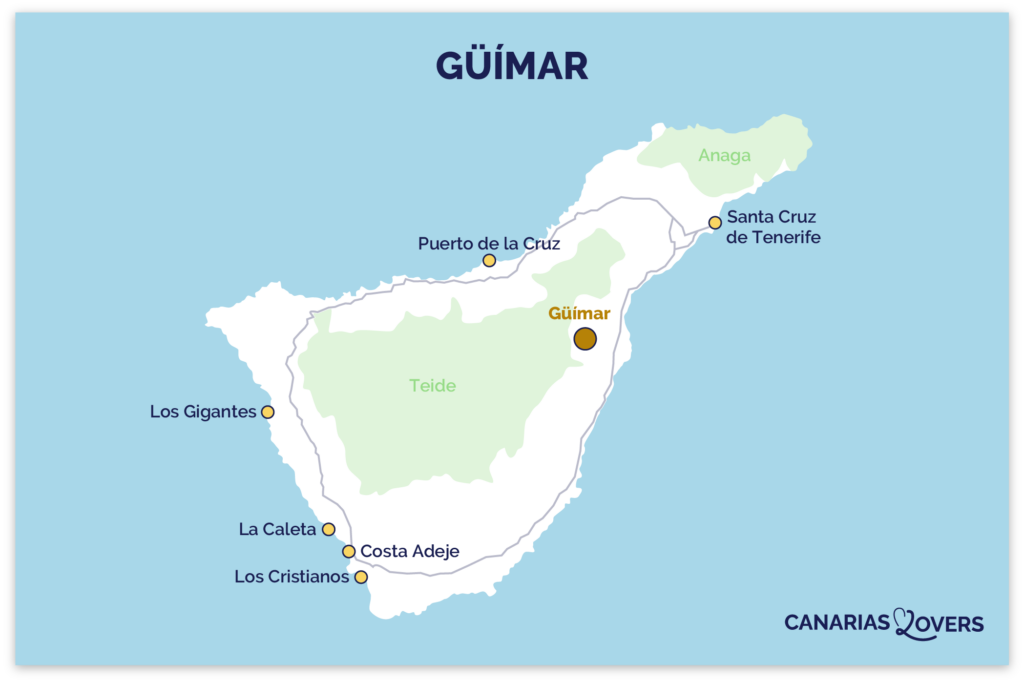Discover the mysterious Pyramids of Güímar, a unique archaeological site in the west of France. of Tenerife, with its enigmatic origins and timeless charm. Nestled in the heart of an ethnographic park, these astonishing structures took us on a fascinating journey through history. With its exotic gardens, cultural exhibits and panoramic views of the Atlantic Ocean, this tour promises an unforgettable, immersive experience.
Check out our useful tips and photos to help you plan your visit and have a great time!

This opinion is completely independent, based on our experiences. We visited the region anonymously, making our own choices and paying our bills in full.
Content
Why visit the Güímar Pyramids Ethnographic Park?
Is the Güímar open-air museum worth it? Our opinion:
Absolutely! The pyramids are well worth a visit for history buffs and the simply curious. This ethnographic park offers a fascinating immersion in the archaeological theories, ancient traditions and exotic landscapes of Tenerife. With its educational exhibits and original installations such as the poison garden, it guarantees an enriching visit full of discoveries. In our opinion, this site is a must for an extraordinary cultural and natural experience!

Why is the Güímar Pyramids Ethnographic Park famous?
The ethnographic park is famous for its 6 mysterious pyramids and their stepped structures. They were built in strict alignment with the summer and winter solstices. They fascinated us with their enigmatic origins. Founded by explorer Thor Heyerdahl, this open-air museum is intriguing for its archaeological remains, which bear witness to the passage of ancient civilizations. The park also hosts cultural exhibitions and a large botanical garden.

Our favorite moments
Here are our 3 favorite moments from our visit:
- The view of the pyramids, the garden and the ocean on the horizon.
- The auditorium, where a short film tells the story of Thor Heyerdahl, and the room dedicated to his transoceanic expeditions.
- A stroll through the garden that winds around the pyramids brings you closer to them.

History in brief
The park was founded in 1998 on the initiative of Thor Heyerdahl. He recognized the great heritage value of these pyramids, built on several levels and oriented towards the sun. During our visit, we watched a film about his life and work in the auditorium. Norwegian explorer and anthropologist, he owes part of his fame to his crossing of the Pacific Ocean on a wooden raft named Kon-Tiki in 1947. Find out more here. Now deceased, he continues to inspire researchers and archaeology enthusiasts alike.

WHERE TO STAY IN Tenerife
Our independent picks for the accommodation of your dreams:
- Where to stay in Tenerife
- Our favorite: Hotel Corales Beach
Select by hotel type:
- 5-star hotels
- Best boutique-hotels
- Best hotels for families
- Best hotels in Seaside
- Best adults-only hotels
- Best all-inclusive hotels (coming soon)
Select by city:

Access and map: Pyramides de Güímar in Tenerife
Where is the open-air museum?
- East of the island of Tenerife,
- In the village of Güímar,
- In Calle Chacona,
- Driving time from Candelaria: 15min,
- Driving time from Santa Cruz de Tenerife: 30min,
- Driving time from El Médano: 35min.
Our map will help you find your way around the island:

How to get there?
To reach the historic site, you can choose between 2 options:
- by car: this is the easiest way to get to the pyramids, as they are located in a small village far inland. Wherever you start from, you’ll take the TF-1 main road, then exit towards Güímar. Once you arrive in the village, we advise you to drive slowly. Some streets are narrow.
- public transport: several buses pass through the village. The nearest bus stop is called “Pirámides”, a 10-minute walk from the open-air museum. Find out more on the official website of the local transport network here.
OUR TIPS TO RENT A CAR IN Tenerife
- Compare prices on our preferred platform: DiscoverCars – one of the best rated sites.
- If you’re planning to explore the mountains, don ‘t take the smallest cars. A more powerful engine will be more comfortable.
- But don’t take too big a car either, as some roads are narrow.
- There’s a lot of demand and it’s an island, so book early.

Parking
Free parking is available directly opposite the museum entrance, with herringbone parking. They are limited. Alternatively, you can park further away in the village of Güímar.

Useful tips: duration, schedules, eating…
Best time to visit
Preferably outside the summer season (July, August) and school vacations. This way, you can avoid peak periods. Choose morning slots as soon as they open, or during lunchtime. Attendance is generally lower in these slots. What a pleasure to discover the almost empty garden paths! We enjoyed the view in peace and quiet.

Length of visit and main difficulties
The length of your visit will vary according to the package you choose, but you should allow between 1 and 2 hours.
The official website states that the park is accessible to people with reduced mobility. We have noticed access ramps, adapted toilets and other tailor-made facilities. The area is vast, however, and you’ll have to tackle some very narrow trails. If you have any questions on this subject, please do not hesitate to contact reception directly at piramides@piramidesdeguimar.es.

Advice on how to visit
The direction of visit is not imposed. We suggest, however, that you start with the museum just opposite reception. Then head for the auditorium, where a film is shown on a large screen. After that, it’s time for a full tour of the large garden housing the mysterious pyramids. It was our favorite part!

Along the way, you’ll observe lush flora and fauna. You’ll conclude your visit with the various exhibition areas to the west of the park, then head up the path to the reception area. You’ll find plenty of directional and informative signs along the way.

A LITTLE MORE patience
All the photos, maps, information and addresses you need to make your stay in the Canaries a success will soon be available in a single ebook!
If you’d like to be notified when our guide to the Canaries is published, please subscribe:

Visiting with children
We noticed the little games and quizzes aimed at children, which punctuate the visit and give it a playful, educational feel. They can build their own pyramids using foam blocks. They’ll also have fun in the play area in the garden. We highly recommend this activity for families!

Schedules and rates
The park is open daily from 10 a.m. to 6 p.m., except on January 1 and December 25.
The site offers 2 visit formats:
- Premium Experience: lasts 2 hours and gives access to the entire ethnographic park and exhibitions for €18 per adult and €8 per child (7 to 12 years).
- Pyramids & much more: lasts 1 hour and includes the main points of interest (pyramids, museum, auditorium and garden) for €12.50 per adult and €6 per child.
>> Book your tickets now here <<
Guided tour
The site provides audio guides in several languages, so you can explore the ethnographic park at your own pace. You’ll need to ask at reception on arrival.

Catering
You’ll find the Kon-Tiki Cafeteria right on the premises. Ideal for a lunch break with family or friends. With its large picture windows, it offers a view over the site. It also offers a Brunch option between 11am and 1pm for those wishing to extend their visit. Find out more here.
Otherwise, we noticed a landscaped area with numerous picnic tables in the garden. Don’t forget to bring your packed lunch with you!
For more options, there are several restaurants in the village of Güímar, around the Iglesia De San Pedro, but you’ll need to walk about 10min to reach them.

Subscribe to our Newsletter
- Get away from it all with Region Lovers’ beautiful destinations!
- Once a month
- Advertising-free
The adventure begins
Your adventure begins now, on the threshold of a mysterious and enchanting site where every stone tells the ancient and fascinating story of the Pyramids of Güímar. Let us guide you through this unique place, where history and nature intertwine to reveal the secrets of ancient civilizations.
La Casa Chacona

Opposite reception, Casa Chacona was the starting point for our visit. It houses a museum that plunges us into the history and mysteries of ancient civilizations. It reveals a collection of artefacts and archaeological objects, offering a glimpse into the practices and beliefs of ancient peoples. Explanatory panels and miniature models shed light on the various hypotheses surrounding the pyramids and potential links with other ancient cultures. Although the museography is a little dated, it provides an effective introduction to the subject!

After visiting the museum, we headed for the auditorium. Along the way, we came across a sculpture of a mythological character that we immediately recognized. Did you find it? It’s Atlas who carries the vault of heaven. We then discovered a viewpoint overlooking the pyramids, with the ocean on the horizon. We also found information on the formation of the Canary archipelago and its rich volcanic past.

The auditorium and expedition hall
Before entering the auditorium, you’ll see an impressive large-scale replica of the Ra II reed boat. It introduces the subject of the film, as it is identical to the one used by Thor Heyerdahl to cross the Atlantic Ocean in 1970. As a reminder, he popularized the Güímar Pyramids on an international scale.

Then sit back and enjoy a projection about the famous anthropologist. The short film retraces the life and work of this extraordinary man. This moment marks an instructive pause that allows you to better apprehend the visit. In keeping with the subject, the exhibition hall was a real highlight, with its curious boats, including the famous Kon-Tiki raft mentioned earlier in the article.

HAVE FUN IN TENERIFE: activities

Pyramids in sight
The tour continues to the garden and the majestic pyramids, where nature and ancient architecture blend harmoniously. This outdoor trail invites you to discover exotic flora, with plants from the Canary Islands, as you approach the impressive stepped pyramids. A rewarding exploration of a fascinating landscape awaits you!
The botanical garden

The Ethnographic Park garden is a botanical oasis with a rich diversity of exotic and local plants. As we walked along the pathway that circles the entire outdoor area, we spotted species endemic to the Canary Islands, such as palm and pine trees. Information panels reveal the scientific names of the plants, their history and their importance in the Canarian ecosystem.

The peaceful ambience of this unspoilt setting is ideal for relaxing and reconnecting with nature. Surrounded by lush vegetation, you’ll admire the varied shapes and colors of the plants that populate the garden, while enjoying the exotic fragrances wafting through the air. This walk, which takes us away from the hustle and bustle of modern life, immerses us in the mysterious atmosphere of the site and brings us closer to the pyramids, whose enigmatic silhouettes are gradually taking shape on the horizon.

Staircase pyramids
At the heart of the Güímar site, the pyramids arouse fascination and curiosity. Built from local volcanic stone, they rise in successive terraces, revealing a precise layout that has fuelled numerous theories about their origins. These structures, aligned with the solstices, bear witness to a mysterious know-how and invite us to imagine the beliefs and practices of the island’s ancient inhabitants.

Although we didn’t go inside the pyramids, a stroll around these impressive structures proved to be most rewarding. It offers different perspectives on the pyramid complex. The path is lined with informative panels that reveal the history, theories and mysteries surrounding these staircase buildings. These explanations help us better understand the archaeological importance of the pyramids and appreciate the ingenuity of their construction.

Beneath Pyramid 1 of the Güímar complex lies a natural and historical treasure: a volcanic tunnel. Inside this geological formation, a cave has been discovered called the Cueva Chacona. It contained archaeological remains linked to an ancient Guanche hearth. This major find demonstrates that the first inhabitants of Tenerife used this space as a habitat, adding a new dimension to the mystery of the pyramids. The discovery of this information aroused our curiosity! The park even offers a volcanic route that reveals the secrets of the Canary Islands’ geological formation.

A LITTLE MORE patience
All the photos, maps, information and addresses you need to make your stay in the Canaries a success will soon be available in a single ebook!
If you’d like to be notified when our guide to the Canaries is published, please subscribe:

End of shipment
Before ending your visit, head for the ethnographic park’s last exhibition areas, accessible as part of the complete package. They shed light on Polynesian society and the decline of this distant civilization that originated on Easter Island, as well as the colonization of the Pacific Ocean by Polynesians. Finally, you’ll discover 2 stunning gardens.
Complementary exhibitions

Complementary exhibits enrich your park experience by offering a broader perspective on ancient cultures and the fascinating stories that surround them. They cover a wide range of themes, from the colonization of the Pacific Ocean to the great achievements of Polynesian society. The decline of this civilization underlines the depletion of natural resources, reminding us of the crucial importance of sustainability and the need to preserve our environment. You’ll be immersed in a story that will get you thinking about today’s major environmental challenges.

The tropicarium and the poison garden
The tropicarium is the fruit of a botanical project in collaboration with the University of La Laguna. In the greenhouse, you can admire the amazing survival strategies of orchids and insectivorous plants, which thrive in this tropical environment. Did you know that these exotic species fascinated the illustrious naturalist Charles Darwin? To take advantage of this unique botanical experience, please ask at reception for tour times.

Before leaving the park, don’t miss a detour to the Poison Garden, a fascinating last stop that highlights the beauty and danger of poisonous plants. This garden is home to an impressive variety of over 70 poisonous species from all over the world. We even observed a few in cages to avoid contact. As you stroll among these specimens, you’ll discover their unique characteristics, their medicinal uses, their degree of toxicity, and the legends associated with them.

PLAN YOUR TRIP TO tenerife
- Best of
What to do in Tenerife
Most beautiful towns and villages
Most beautiful beaches
Best natural pools
Most beautiful landscapes
Most beautiful roads
Amusement parks
Best boat tours (coming soon)
Secret places, off the beaten track (coming soon)

- Practical advice
25 tips for a successful trip to Tenerife
How to get around
How to rent a car in Tenerife
Driving tips
Best excursions (coming soon)
Where to stay in Tenerife
Itineraries: 3 days – 4 days – 5 days – 6 days – 1 week – 10 days

- The must-dos
Dolphin watching in Tenerife (coming soon)
Teide National Park
Anaga Rural Park (coming soon)
La Orotava
Garachico
Village of Masca
Pyramids of Güimar




